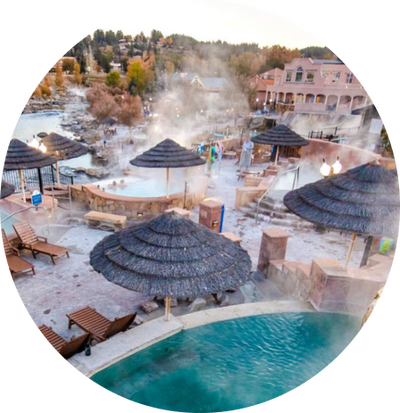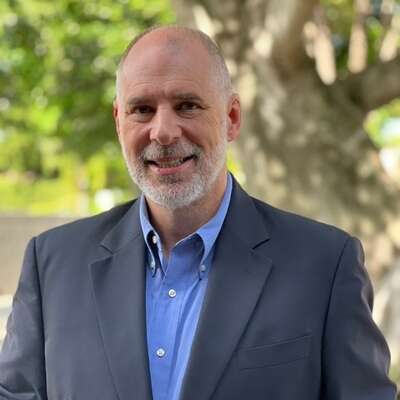
Building Tomorrow is a curated series offering exclusive one-on-one discussions with prominent executives across the real estate spectrum. Through a refined lens, each installment unpacks trends, challenges and exemplary leadership strategies steering the trajectory of specific segments within the real estate landscape, offering a concise yet comprehensive understanding of market dynamics.
This interview features Greg Zimmerman, Executive Vice President and Chief Investment Officer at EPR Properties. Part one of three explores the wide array of investment prospects and ventures in experiential real estate, spanning attractions, wellness resorts, water parks, and innovative entertainment concepts, while also highlighting the firm's strategic expansion into various regions. In parts two and three, we discuss EPR’s business model and Greg's approach to leadership.
Part I: Experiential Real Estate
Boyden - EPR is known as the "experiential real estate" company. What does that mean?
Zimmerman - Our real estate venues drive value by facilitating out-of-home leisure, recreation, and social experiences. Places where consumers choose to spend their discretionary time and money make up the social infrastructure of society. Our investments include theaters, amusement parks, gaming, fitness, and wellness concepts, experiential lodging/resorts, and cultural offerings such as museums.
Boyden - How have investors’ perceptions of your business changed over the years?
Zimmerman - I think the most significant change is the perception of theaters. I’ve been around long enough to understand that real estate cycles ebb and flow. I lived through the 1990s with developers just trying to survive, the financial crisis of 2008-2009, and then COVID. One thing that’s always true is that developers overbuild. They have to be optimistic – that’s part of the job. And unfortunately for a lot of the optimists, reality sets in late in the cycle. I tie that back to theaters because many developers wanted to have a theater anchor their retail projects. A lot of overbuilding was funded, and we are probably still overscreened in the U.S. The United States is over-officed and over-malled as well. The challenge with theaters is that there’s almost always someone who is willing to operate a theater. It doesn’t have to be AMC, Regal, or Cinemark; some operators have it in their blood. They just want to run it and figure out how to make a little bit of money. So we’re always struggling with an oversupply of theaters.
Boyden - What hasn’t changed?
Zimmerman - Real estate is location-based, as we all know. I went to the Rouse Company thirty years ago, and the first thing one of my colleagues told me was, “Welcome to Rouse. Malls are a mature industry and they’re dying.” True! Thirty years later, many malls have died. On the other hand, well-located malls – including many developed by Rouse – are still here and still thriving. Same thing for theaters. You can have a good theater in any market, not just in Times Square. It just has to be a good theater in a good location.

Boyden - Anything else?
Zimmerman - The other thing that’s really important is changing to survive. We were ahead of the curve in remodeling our theaters, adding better seats, large-format screens, adult beverages, among other things like that. In that sense, our theaters came out of COVID stronger. Those are the things people want today; they want to be able to see a picture on IMAX and other proprietary large-screen formats, and they want to have a beer or a glass of wine.
Boyden - How has streaming affected the theater business?
Zimmerman - The interesting thing about streaming is that like TV, VHS, and DVD, streaming was supposed to kill theaters. It hasn’t. COVID was an accelerant for resolving that issue because most studios who released movies straight to streaming lost money. David Zaslav, the new CEO of Warner Bros. Discovery, said the model of spending hundreds of millions of dollars on a movie, then to release it only on streaming was "deeply flawed." The only way to monetize streaming is to increase the number of subscribers. It’s just a failed business model. Compare that to when you release a film to theaters for 45 days, make $50-75 million, then release to streaming.
Boyden - That makes sense for the blockbusters. What about small-budget films and art house theaters?
Zimmerman - What has happened is the consolidation of studios: Amazon now owns MGM, Disney now owns Fox, and the studios are more risk-averse. It's tougher to release smaller art house films and make money. There’s still a niche for individual studios – the Lionsgates of the world – but it’s harder to get those films made and to make money on them. Studios need to be creative. For example, Amazon and Ben Affleck did The Michael Jordan story. It was originally going to be only on Amazon, but they released it in theaters and probably made $50-60 million. A little more than an art house film, but it’s not Aquaman or the Marvel Cinematic Universe. We’re seeing some readjustment. It’s harder for a theater to be only an art house.
Boyden - What’s the future of experiential real estate investing?
Zimmerman - We said publicly, even before COVID, that we want to reduce our exposure to theaters. It’s partly because of the noise around theaters with investors. Also, since EPR began with acquisitions from AMC, we’ve always been over-indexed to theaters. They represent 39% of our revenue, and that’s not what investors want; they want a more diversified portfolio. But our exposure to theaters won’t ever be zero because we believe in the business. To go to the metrics: Before COVID, we had 3% of the screens in North America, and we generated 8% of the box office. That number is getting closer to 9% of the box office coming out of COVID, and that’s because our theaters are well-located, and we have a large number of premium large-format screens. On a screen-by-screen basis, our screens over-index North America on a box office gross basis by 10-15%, post-COVID. And we are the largest owner of theaters in North America.

Boyden - Beyond theaters, what are the big opportunities?
Zimmerman - We have multiple verticals that we consider to be experiential: Attractions, eat-n-play, casino gaming, fitness & wellness, and cultural. We have opportunities in all those verticals. In 2022, we did around $600 million in total investments touching every vertical except for theaters and gaming. For example, in fitness and wellness, we own The Springs Resort in Pagosa Springs, Colorado, which did extremely well during Covid. It’s a natural hot springs resort. It is expanding, with the operator building new facilities. The operator also found what used to be a natural hot springs resort in Murrieta, California, midway between San Diego and Los Angeles. It started as a hot springs resort in the 1920s for Los Angeles and Hollywood. It was outflanked by Palm Springs, then went through a bunch of iterations through the years. Ultimately it became a bible college and conference center and eventually went up for sale. Our operating partner acquired the property with our funding, and we were open in February with our second natural hot springs resort. Another great story in fitness and wellness is a brand called Gravity Haus, providing lodging in ski resort towns and other places with natural attractions. Small hotels, 40-50 rooms, great food & beverage, other amenities, such as co-working space, fitness centers. In Breckenridge, it’s a 100-foot walk to the ski lift. They are four-season resorts. We have them in Breckenridge, Vail, Aspen, Winter Park, Steamboat Springs -- all over Colorado – and Truckee. We’re really excited about that. We did a couple of climbing gyms last year, one with Movement in Chicago, which is the largest climbing gym chain in the country, and one with Vital in Williamsburg, Brooklyn, where you can see the Empire State Building from the roof. There’s a sauna on the roof, as well as a climbing face. We also bought the largest outdoor water park in Canada in 2022: Calypso Waterpark, and a large indoor waterpark and hotel at Villages Vacances Valcartier in Quebec. There’s a very large universe of experiential real estate for us to invest in.
Boyden - So you’ve gone back to Canada!
Zimmerman - We probably have a billion dollars invested in Canada. We have four entertainment-retail centers, which are outdoor shopping experiences anchored by a theater. Two are Landmark Theaters and two are Cineplex, the largest theater chains in Canada. Three are in the greater Toronto region, and one is in Ottawa. Again, we have the water park in Ottawa and substantial investment in Quebec.
Boyden - So the arctic climate appeals!
Zimmerman - Yes! Every year, Valcartier constructs a 30-room ice hotel – the Hotel de Glace -- and it sells out. This year, Hallmark actually did a movie, “Baby, It’s Cold Inside”. I was able to see it the night after the last guests were there. It was pretty impressive – so we do need cold weather! Valcartier also has tubing and sledding hills. Again, it’s a four-season resort.
Boyden - So you’re really at the vanguard of all the new recreational and experiential concepts. The deals come to you.
Zimmerman - Absolutely, there is not much we don’t see in the space. This year we’re opening a standing wave surf attraction in Dallas, called Deep Ellum Good Surf. It will be a standing wave, so 2-3 people can surf at one time, surrounded by food and beverage service.
Boyden - What do you mean by standing wave?
Zimmerman - There are different kinds of surf parks. The largest ones generate waves as you would see in the ocean, with multiple people surfing at once. The standing wave is just one wave, which you catch. It’s different from lake surf parks, where you try to replicate multiple ocean waves. Surf parks are great for dedicated surfers because they generate consistent waves, and the surfer doesn’t worry about tides, weather, and other factors.
This concludes Part I of our "Building Tomorrow" discussion with Greg Zimmerman. Parts II & III, set to be released throughout April 2024, will delve deeper into topics such as the business model, resilience within the real estate industry, proactive investor relations, leadership approach, and team culture. These discussions aim to illuminate the factors that drive organizational agility, setting the stage for adaptability and sustained growth in an ever-evolving landscape.
Executive Biography
As Executive Vice President and Chief Investment Officer of EPR, Greg Zimmerman leads, manages, and develops the Investment, Underwriting, and Asset Management teams, including the Experiential and Education Groups. Mr. Zimmerman oversees all new investment origination, underwriting and closing activities, as well as the organization’s investment policy and risk management, broadly including market, asset, tenant, credit and development risk and concentrations.
Mr. Zimmerman was appointed Executive Vice President and Chief Investment Officer in 2019. Prior to joining EPR Properties, Mr. Zimmerman was the Executive Vice President of Development at Washington Prime Group. From 2008 to 2015, Mr. Zimmerman served as Senior Vice President of Big Box, Theatre and Peripheral Development with Simon Property Group. Earlier in his career, he served as Vice President of Real Estate at Macerich Company and held a variety of development and legal roles at The Rouse Company. Prior to joining Rouse, Mr. Zimmerman was a real estate attorney in the Baltimore office of Venable LLP. Mr. Zimmerman received his J.D. cum laude from the University of Pennsylvania Law School and a B.A. with honors in history from Dickinson College, graduating summa cum laude.






